In the realm of construction and industrial settings, fiberglass strut channels have emerged as a prominent choice for structural support and framing. These versatile components, often referred to as fiberglass Unistrut, are manufactured from fiberglass-reinforced resins, offering a compelling blend of strength, durability, and lightweight properties. Their unique characteristics have propelled them to the forefront of various applications, making them an invaluable asset in a diverse array of projects.
Applications of Fiberglass Strut Channels:
Fiberglass strut channels have found their way into a multitude of applications across various industries, primarily due to their versatility and adaptability. Some of the most common applications include:
Electrical Conduit Support: Fiberglass strut channels are widely used to support and organize electrical conduits, cables, and wires in commercial and industrial settings. Their non-conductive nature ensures safety while providing a robust mounting platform.
HVAC System Support: Fiberglass strut channels play a crucial role in supporting HVAC ductwork, pipes, and other components. Their lightweight construction minimizes the burden on the building structure, while their corrosion resistance ensures long-lasting performance in challenging environments.
Piping Systems: Fiberglass strut channels are employed to support and secure piping systems in various applications, including plumbing, industrial processes, and fire protection systems. Their strength and resistance to harsh conditions make them ideal for these applications.
Equipment Racks and Mounting Systems: Fiberglass strut channels are often utilized to construct equipment racks, mounting brackets, and shelving units in laboratories, warehouses, and manufacturing facilities. Their versatility allows for customized designs to accommodate specific equipment and storage needs.
Temporary Structures and Scaffolding: Fiberglass strut channels are frequently used in the construction of temporary structures, such as scaffolding, staging, and work platforms. Their lightweight and easy assembly make them suitable for quick setup and dismantling.
Advantages of Fiberglass Strut Channels:
The widespread adoption of fiberglass strut channels can be attributed to several distinct advantages they offer over traditional steel or aluminum strut channels:
Corrosion Resistance: Fiberglass strut channels are highly resistant to corrosion, making them an excellent choice for applications in harsh environments, such as coastal areas, chemical plants, and wastewater treatment facilities. Unlike steel strut channels, which are susceptible to rust, fiberglass strut channels maintain their integrity and appearance over time.
Lightweight: Fiberglass strut channels are significantly lighter than their steel or aluminum counterparts, reducing the overall weight of the structure and simplifying installation. This lightweight property is particularly beneficial in situations where weight restrictions or load-bearing limitations exist.
High Strength: Despite their lightweight nature, fiberglass strut channels exhibit remarkable strength and can withstand significant loads. This strength-to-weight ratio makes them suitable for demanding applications where both strength and weight considerations are crucial.
Electrical Insulation: Fiberglass strut channels are non-conductive, providing electrical insulation and safety in applications involving electrical components or equipment. This property eliminates the risk of electrical hazards and ensures a safe working environment.
Radio Frequency Transparency: Fiberglass strut channels are radio frequency (RF) transparent, allowing for the unobstructed passage of radio waves and signals. This characteristic is particularly advantageous in applications where RF communication is essential, such as in healthcare facilities and telecommunication installations.
Low Maintenance: Fiberglass strut channels require minimal maintenance, unlike steel strut channels that need regular painting or treatment to prevent corrosion. This low-maintenance nature reduces long-term costs and simplifies upkeep.
Disadvantages of Fiberglass Strut Channels:
Despite their numerous advantages, fiberglass strut channels also have some potential drawbacks that should be considered:
Higher Initial Cost: Fiberglass strut channels generally have a higher initial cost compared to steel or aluminum strut channels. However, their long-term cost savings due to reduced maintenance and extended lifespan may outweigh the initial higher cost.
Lower Tensile Strength: While fiberglass strut channels exhibit impressive strength, they have lower tensile strength compared to steel strut channels. This may make steel strut channels a better choice for applications requiring exceptional tensile strength.
Bond Strength: The bond strength between fiberglass strut channels and concrete is generally lower than that of steel strut channels. This may require special considerations in design and construction.
Conclusion:
Fiberglass strut channels have emerged as a compelling alternative to traditional steel or aluminum strut channels, offering a unique combination of corrosion resistance, lightweight construction, high strength, electrical insulation, and radio frequency transparency. Their versatility and adaptability make them suitable for a wide range of applications across various industries,
 +86 15303735673
+86 15303735673 Jessica@frpzs.com
Jessica@frpzs.com
 Technical Data
Technical Data













